|
|
|
|
 PART ONE PART ONE  || PART TWO || PART TWO

Junrei 巡礼 = Pilgrimage
RESOURCE GUIDE
JAPANESE PILGRIMS & PILGRIMAGES
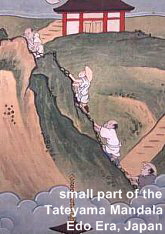
INTRODUCTION. In Japan, pilgrimages can be classified into two general types: (1) multi-site circuits and (2) single-site pilgrimages. Multi-site circuits involve a number of sacred places linked together numerically, with each location devoted to the same single deity or to a group of related deities. This is known as honzon junrei 本尊巡礼—literally to wander around (jun 巡) to worship (rei 礼) the principle deity (honzon 本尊). In order to complete the pilgrimage, participants are obliged to visit every single site on the circuit. Each site is equally important and none serve as the center or definitional locus. Although the sites are assigned numbers, participants can visit them in any order (the only prerequisite is that “all” are visited). The numbers indicate the most convenient route for those who are unfamiliar with the circuit’s logistics. Multi-site pilgrimages need not be completed in a fixed timeframe. Instead, participants can perform the circuit in multiple journeys spread out over any length of time. In bygone times, pilgrims often wore special pilgrimage garments. Today most wear everyday clothes and carry a book (nōkyō-chō 納経帳) that can be purchased at any site along the route. This book is then stamped (for a small fee) at each site visited. These stamps (shu-in 朱印) are often very artistic, but their main function is to serve as a testimony to the pilgrim’s completion of the journey. Two of the most popular multi-site pilgrimages are the 33 Sites Sacred to Kannon in Western Japan and the pilgrimage to 88 Holy Sites of Shikoku.
Single-site pilgrimages involve a journey to one particular sacred site. Pilgrimages in this latter group include those to Ise Shrine 伊勢神宮 (Mie) and Izumo Taisha Grand Shrine 出雲大社 (Shimane), Mt. Koya 高野山 (Wakayama), Mt. Fuji 富士山, Mt. Haguro 羽黒山 (Yamagata), Mt. Hakusan (northwest Honshū), and many other holy mountains sites, and the Kumano Sankeimichi 熊野参詣道, which involves visiting the three shrines of the Kumano Sanzan 熊野三山 complex (Wakayama).
It is thought that pilgrimages were first undertaken in the Nara Period (710-794 AD), but the custom did not become popular until the Heian Era (794-1185 AD). Kumano, in southern Wakayama Prefecture, became a large center for adherents and pilgrims of the Shugendō sect during the Heian Period. Other popular pilgrimages at the time were to Hasedera (Kyoto), Shitennō-ji (Osaka), and Mt. Koya.
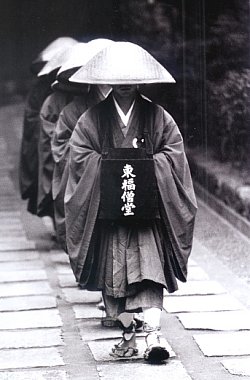
Tofukuji Temple, Kyoto, 1992
Monks going for alms.
Unknown Photographer (name not given at web site)
In the Edo Period (1600-1868 AD) the number of people making pilgrimages to both Buddhist temples and Shinto shrines increased rapidly, especially to Ise Shrine, Kotohira Shrine (Kagawa), the 88 temples of Shikoku and Western Japan, to Zenkoji (Nagano), Kiso Ontake (Nagoya), and Mt. Fuji (Shizuoka). One phenomenon of the Edo era was Okage Mairi お蔭参り -- the special pilgrimage to the Ise Jingu Shrine. The Okage Mairi tradition continues unabated even today, with approximately six million people visiting Ise Jingu Jingu yearly.
The reasons for making a pilgrimage are as diverse as the people who make them. Common elements in pre-modern times included a sense of quest, spiritual advancement and the promise of this-worldly and next-worldly benefits. But today, the forces of science-based education, secularization, urbanization, ease-of-travel and tourism have muted the religious tone of many pilgrimages. At popular tourist destinations like Kamakura, pilgrims must now share sacred geography with urban sprawl, rumbling cars and buses, and throngs of tourists taking photos on their smart phones. In many ways, pilgrimage in contemporary Japan is no longer impelled by devotionalism but rather by tourism. People don’t set out with religious motives. They do it because it is a fun way to socialize with friends, to rediscover their cultural heritage, to feed their growing nostalgia for traditions lost to modernization and to enjoy the local delicacies and sights found in other parts of Japan.
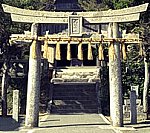 Commercialization of Pilgrimages Commercialization of Pilgrimages
Pilgrimages since the Meiji Period (1868-1912 AD) have basically preserved the patterns that emerged during the Edo era. Nonetheless, most will admit that modern-day Japanese pilgrimages are incredibly commercialized. Many Japanese localities and prefectures, hoping to attract religious tourists, have copied the traditional pilgrimage patterns to establish their own modern circuits for the 33 Kannon and 88 Holy Sites. Today pilgrims travel in luxury by coach, minibus or taxi in prearranged tours. Nearly all modern pilgrims purchase the amulets, hats, satchels, staffs, bells, and other religious paraphernalia that are sold in abundance by temples, shrines, prefectural bodies, cities, and travel agencies. In many ways the modern pilgrimage in Japan is a thinly veiled disguise for tourism, stripped in large part of religious meaning. And let us not forget. Since the Edo Period, Shinto and Buddhist practices among the common folk have been aimed primarily at this-worldly benefits (concrete rewards now). To many Japanese, Shinto and Buddhist faith is primarily involved with petitions and prayers for business profits, the safety of the household, success on school entrance exams, painless child birth, and other concrete rewards now, in this life. This type of popular worship -- one focused on “this-worldly” rewards -- can easily fall prey to commercialism.
Yet, without doubt, there are still true believers -- devoted pilgrims -- those who hope to atone for their sins in this life and gain merit in the next by walking the pilgrimage road. <Above text adapted from Japan - An Illustrated Encyclopedia, published by Kodansha, Oct. 1993, ISBN: 4069310983>
|
PILGRIMAGE TERMS & CONCEPTS
|
|
巡礼 (じゅんれい)
巡礼者 (じゅんれいしゃ)
|
Junrei = Pilgrimage
Junreisha = Pilgrim
|
|
遍路
(へん ろ)
|
Henro = Another word for Pilgrimage. Pilgrims who travel the circuit for the 88 Holy Sites of Shikuku are often called “O-Henro-san.”
|
|
おかげ参り
|
Okage Mairi = Special pilgrimage to the Ise Jingu Shrines made in the "Year of Okage” (every 60 years or so). The custom reportedly began in latter half of Kamakura Era (1192-1333 AD) and became very popular in the Edo Era (1600-1868 AD). Details Here
|
|
朱印
(しゅいん)
|
Shuin = Stamps & Inscriptions. The pilgrim typically collects stamps and inscriptions from each temple/shrine on the circuit. Details Here
|
|
朱印帖
(しゅいんちょう)
|
Shuin-chō = Stamp Book in which the pilgrim collects stamps and inscriptions from each temple or shrine in the circuit. Details Here
|
|
納経帳
(のうきょうちょう)
|
Nōkyō-chō = Stamp Book. Another term for Shuin-chō (see above entry). Details Here
|
|
納経軸
(のうきょうじく)
|
Nōkyō-jiku = Hanging scroll, especially for pilgrimages to Shikoku and to sites sacred to Kannon or Fudo Myo-o; pilgrimage souvenirs; pilgrims often ask the temple to stamp/inscribe these scrolls. Details Here
|
|
御影
(みえい)
|
Mi-ei = Sacred images of the deities, akin to “holy cards” in the Catholic tradition. Details Here
|
|
千社札
(せんじゃふだ)
|
Senjya-fuda = Seal on which is printed the pilgrim’s family name. Traditionally, pilgrims would affix these seals to the gates of each temple or shrine on the circuit as a testament to their visit; this practice was halted in modern times to protect aging temple structures. Details Here
|
|
納め札
(おさめふだ)
|
Osame Fuda = Paper prayer slips. Presented to each site along the pilgrimage circuit. Now used instead of senjyafuda (see above). Details Here
|
|
お接待
(おせったい)
善根宿
(ぜんこんやど)
|
O-settai. Donations to pilgrims; free gifts of food and drink (e.g., tea, fruit) given to pilgrims by locals living along the pilgrimage circuit. Also, when pilgrims are offered a free or really cheap place to spend the night, this is referred to as Zenkon Yado.
|
|
菅笠 (すげ かさ)
持鈴 (じ れい)
木魚 (もくぎょ)
ローソク
御詠歌 (ご えい か)
御詠歌の本 (のほん)
|
Suge Kasa = Sedge hat, pilgrim's hat.
Jirei = Tiny bells to ring while praying.
Mokugyo = Wooden block; strike while praying.
Roosoku = Candles, one for each temple.
Go-eika = Chants for each temple.
Go-eika no hon = Booklet containing the chants.
Other pilgrim articles include white cloths, staff, tiny amulets and rosaries. Details Here
|
|
 This page indebted to the research This page indebted to the research
and assistance of Gabi Greve.
Click here to visit Gabi’s web site.
|

 PILGRIMAGE STAMPS/INSCRIPTIONS (Shu-in 朱印) PILGRIMAGE STAMPS/INSCRIPTIONS (Shu-in 朱印)
When on pilgrimage, it is customary for the pilgrim to collect “stamps” from each of the sites he/she visits, and to collect these stamps in a "stamp book." Some temples only give stamps, while at others, a temple priest will hand-draw the temple’s “signature” in the pilgrim’s book -- these handwritten inscriptions are often very beautiful. When the temple priest is away, the pilgram must settle for the stamp, but the stamps too are quite artistic. Virtually all pilgrims are willing to pay the 500 yen or 1,000 yen it costs to receive the temple stamp and brush-written inscription.
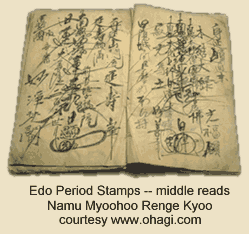
Edo Period Stamps. Most likely made by a monk or believer from the Nichiren Sect of Buddhism, for in the middle of each page is written the main prayer of believers in the Lotus Sutra - Namu Myoohoo Renge Kyoo.
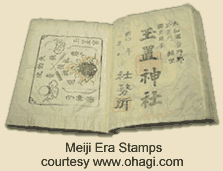
Meiji Period Stamps. This pilgrim visited most of the sites related to the mountain cult of Shugendo during the Meiji Era. Today, many of these sites no longer exist. Those that can still be visited today no longer offer the same stamp or inscription. Shugendo, reportedly founded by En-no-Gyoja, is a branch of the Shingon Sect. It stresses physical endurance as the path to enlightenment. Shugendo's extreme rituals include walking on red-hot coals, chanting while sitting under ice-cold waterfalls, or hanging by the feet from the edge of a cliff.
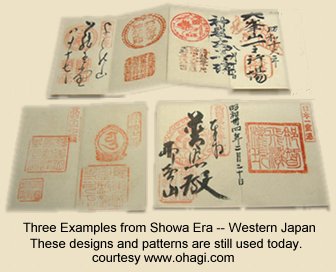
Showa Era Stamps. Three examples from pilgrimages in Western Japan. The designs and patterns found in these three books are still used today.
LEARN MORE ABOUT PILGRIMAGE STAMPS
Most of the sites listed below are written in Japanese, but you can still view their impressive stamp collections and photos without any knowledge of the Japanese language. A picture is worth a thousand words !!!
- Stamps - Kannon 33 Sites in Western Japan (Saikoku)
Japanese, Outside Link. Stamps from sites on this circuit.
- Stamps - Kannon 33 Sites in Kanto Area (Bandou)
Japanese, Outside Link. Stamps from this circuit.
- Stamps - Kannon 34 Sites in Saitama Valley (Chichibu)
Japanese, Outside Link. Stamps from this circuit.
NOTE: The above 100 sites constitute the traditional 100 Sites Sacred to Kannon (English link; this site). This is one of the oldest and most popular pilgrimage circuits in Japan. Making the circuit to each in proper order (Saikoku, Bandou, Chichibu) is said to save the believer from hell and to open the gates to everlasting life.
- Stamps - Shikoku 88 Holy Site
Japanese, Outside Link. Stamps from this circuit.
- Stamps - Kobo Daishi (Kukai) - Western Japan
Japanese, Outside Link. 20 Special Sites Sacred to Kobo Daishi (aka Kukai, also spelled Koubou Daishi) in Western Japan.
- Stamps - Ise Shrine, Mie Prefecture
Japanese, Outside Link. Ise is one of Japan’s most sacred shrines.
- Stamps - General Resource
Japanese, Outside Link. Source of above three photos. Includes photos of stamps and stamp books from Shikoku 88, Kannon 100, Ise Shrine, others. Maintained by Shou Ichiroo.
- Stamps - Nationwide Pilgrimage Stamps
Japanese, Outside Link. Click links in right column to view stamp collections; organized alphabetically (Japanese alphabet); stamps devoted to Yakushi, Amida, Shaka, Kannon, et. al.

PILGRIMAGE STAMP BOOKS
Shuin-chō 朱印帖, or Nōkyō-chō 納経帳
Pilgrims usually carry a stamp book, which they typically purchase at the first temple or shrine along the circuit. The pilgrim pays the custodian at each temple or shrine to stamp/inscribe their book as proof of their visit. Both the stamps and the book covers are often quite artistic.
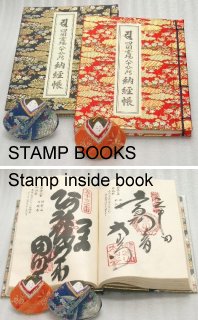
Courtesy Pilgrim’s eStore at:
www.eitikai.co.jp
Japanese, Outside Link
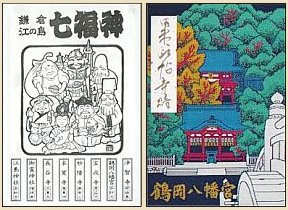
(L) Kamakura -- Cover, Seven Lucky Gods Pilgrimage Book
www2s.biglobe.ne.jp/~terra/syuin/syuinc.cgi?coverlist=6
(R) Kamakura -- Cover, Tsurugaoka Hachimangu Shrine Book
www2s.biglobe.ne.jp/~terra/syuin/syuinc.cgi?coverlist=2
NOTE: Japanese Site, Outside Link
Visit the above two links to see many more book covers.
Change numeral in “coverlist=X” from 1 to 9 to view all nine pages.
Shikoku -- Online Purchase of Pilgrimage Stamp Books
Ranging from $20 to $60 each. Japanese Language Sites.
www.taihodo.co.jp/FS-Shop/shop/etc-4_1.html
www.eitikai.co.jp/zyunpaiyouhin-noukyoutyou.htm

|
 PILGRIMAGE SCROLLS PILGRIMAGE SCROLLS
Nōkyō-jiku (Nokyo-jiku) 納経軸
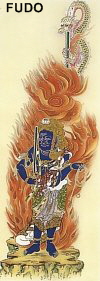 Hanging scrolls are pilgrimage souvenirs, and pilgrims often ask the custodian of the temple to stamp or inscribe such scrolls. Found most frequently for pilgrimages to the 88 Holy Sites of Shikoku, for Kannon Pilgrimages, and Fudo Myo-o pilgrimage circuits. Hanging scrolls are pilgrimage souvenirs, and pilgrims often ask the custodian of the temple to stamp or inscribe such scrolls. Found most frequently for pilgrimages to the 88 Holy Sites of Shikoku, for Kannon Pilgrimages, and Fudo Myo-o pilgrimage circuits.
Purchase Scrolls Online
Japanese Language Site
|

|
 PILGRIMAGE PRAYER SLIPS = Osame-fuda 納め札 PILGRIMAGE PRAYER SLIPS = Osame-fuda 納め札
Pilgrims offer their osame fuda paper “prayer slips” at each temple or shrine they visit. For novice pilgrims, white osame-fuda are offered for their 1st through 9th pilgrimage. On their 10 through 19 pilgrimage, the pilgrim graduates to the red slip, for 20 through 29 the silver slip, and for 30 onward the seasoned pilgrim can now offer the golden slips. The color of the slip allows other pilgrims to know if you are a beginner or a veteran.
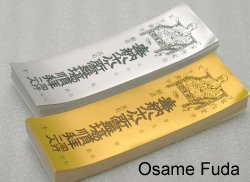
However, depending on your source, these guidelines may differ. Some sources say the novice should offer the white slip for their 1st through 4th pilgrimage, green slips for 5 through 7, red slips for 8 to 24, silver slips from 25 to 49, and gold slips from 50 onward. Once you’ve made 100 pilgrimages, you can reportedly become a leader of pilgrimage groups. Let an example serve. Assume you’ve walked the complete circuit covering all 88 Shikoko Holy Places. That counts as ONE pilgrimage. You would need to walk the complete circuit FOUR times before you could begin to offer the green osame-fuda.
Osame Fuda slips are probably burned in the giant temple/shrine bonfires that mark the beginning of each New Year. Among Shingon temples, however, they are probably burned at the regular Goma Kuyoo on the 28th of each month. <editor’s note: must confirm disposal methods >
|

|
 PILGRIM NAME LABELS / STICKERS PILGRIM NAME LABELS / STICKERS
Senjya Fuda (Senjafuda) 千社札
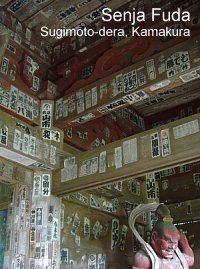 Name stickers that pilgrims paste or stick on the temple gate or shrine gate to prove that they visited that location. In modern times, most pilgrimage sites no longer allow this, primarily as a means for protecting the aging temple/shrine structures. Instead, pilgrims now offer osame-fuda prayer slips (see above entry). Name stickers that pilgrims paste or stick on the temple gate or shrine gate to prove that they visited that location. In modern times, most pilgrimage sites no longer allow this, primarily as a means for protecting the aging temple/shrine structures. Instead, pilgrims now offer osame-fuda prayer slips (see above entry).
In the old days, you needed a special long (telescope-like) pole to stick them really high up on the rafters and ceilings of the gates. The senjya-fuda tradition apparently became popular during the Edo Period (1603-1867), when many believed that good fortune would come to them while their sticker remained attached to the temple or shrine gate. Despite modern rules that forbid pilgrims to paste these stickers on the temple/shrine gate, the senjya-fuda tradition still thrives in other ways in modern Japan. Many commercial shops will make customized stickers just for you -- i.e., with your family name, crest, and image of your choice. The Japanese paste these stickers just about anywhere, on their cars, on cell phones, post boxes, gifts.

Modern Usage Examples
http://senjafuda.hp.infoseek.co.jp/index2.htm (Japanese Site)
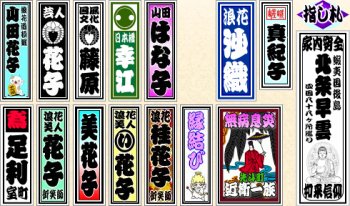
Above Image: eStore Selling Senjya Fuda
Japanese language site. About $5 for set of 12 stickers.
www2.odn.ne.jp/~cbx41100/orizinaru02.htm
MORE EXAMPLES
barenforum.org (English; order customized stickers online)
www.ohmigallery.com/Sales/Bin/Senshafuda.htm (English)
www.sanojian.net/senjafuda/senjafuda01.html (Japanese)
www.sanojian.net/senjafuda/senjafuda02.html (Japanese)
http://senjafuda.hp.infoseek.co.jp/back1.htm (Japanese eStore)
www2.odn.ne.jp/~cbx41100/sub518.htm (Japanese, Card Game)
www2.odn.ne.jp/~cbx41100/sub502.htm (Japanese, Family Crest)
www2.saganet.ne.jp/cook/jsample.html (Japanese)
|

|
 SACRED IMAGES. “Osugata” or “Mi-e” 御影 SACRED IMAGES. “Osugata” or “Mi-e” 御影
A drawing or illustration (generally black and white) of the temple’s central deity. In addition to collecting hand-brushed stamps at each site along the circuit, prigrims may also collect small paper slips depicting the central deity at each temple. Known as Osugata or Mi-ei, these illustrated paper slips cost three hundred yen each and are collected together in a pilgrimage book called an Osugata-chō. In many ways, the mi-ei (sacred pictures) that are collected along the pilgrimage circuit are similar to the Christian tradition of "holy cards."
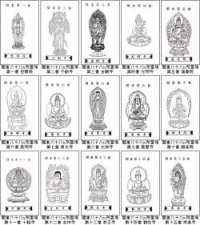
Kanto Region -- Pilgrimage to 88 Sites
www5f.biglobe.ne.jp/~fkm-ito/htmlmie/mrj34/frmmrj34.htm
Japanese. Osugata from the Kantō Pilgrimage to 88 Sacred Sites.
Includes many sacred images of Kannon, the Myō-ō, many others.
Shikoku -- Pilgirmage to 88 Sites
www.ohagi.com/jisha/syuin/shikoku88_miei.htm
Japanese. Sacred images from 17 sites on this circuit.
|

|
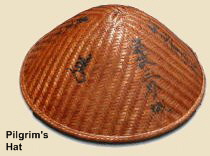 ESTORE FOR THE PILGRIM ESTORE FOR THE PILGRIM
Please see: www.eitikai.co.jp
Japanese. All the things you need on a pilgrimage, from the stamp book to the white cloths, little amulets, bag for your belongings, staff and hat, slips of prayer paper, and much more.
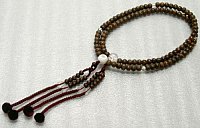 ROSARY -- NENJU 念珠 ROSARY -- NENJU 念珠
Also called juzu 数珠, 誦数. A string of beads or a rosary, used for Buddhist prayer and invocation. Associated particularly with a chant repeating the name of Amida Nyorai. The number and shape of the beads varies, but the most common type has 108 beads. Rosaries were introduced to Japan with Buddhism. Originally rare and precious, the spread of Buddhism brought wider use of "nenju" from the Heian Period (8th-12th century) through the Kamakura Period (12th-14th century). Permission to trade in rosaries during the Edo Period (17th-19th century) made them available to the general public. Kyoto has many head temples of various Buddhist sects, and the techniques of making rosaries have been passed down from generation to generation. The number “108” is a sacred number in many Buddhist traditions. It is said to represent the number of earthly passions and desires that blind and delude us, entrapping us in the Six States of Existence (the wheel of life, the cycle of samsara, the cycle of suffering and reincarnation). At the end of each year, Japanese temples strike a large bell 108 times to symbolically awaken us from our delusions. This bell-ringing tradition is called Joya-no-Kane (除夜の鐘).
 STAFF -- SHAKUJŌ 錫杖 (Sanskrit = khakkhara) STAFF -- SHAKUJŌ 錫杖 (Sanskrit = khakkhara)
Below text courtesy JAANUS www.aisf.or.jp/%7Ejaanus/
Also called ushojou 有声杖, chijou 智杖, and tokujou 徳杖. A pilgrim's staff or sistrum. In Japan the shakuj usually consists of a wooden handle or pole topped with a metal finial with two sections, each with three rings, for a total of six rings, which represent the Six States of Existence -- the cycle of samsara, of suffering and reincarnation; in Japan, Jizō Bōsatsu is often shown holding this staff). In India, the shakujou's metal rings were originally used by traveling priests to alert small creatures to keep them from accidentally being harmed by a priest when walking in the woods. It was also used to frighten away dangerous snakes or beasts that the priest might have encountered. The shakujou could also serve as a cane to help the priest walk. When begging, he rattled this staff to announce his arrival at the door or gate of a household without breaking the vow of silence. In Japan the shakujou is still used by monks, pilgrims, and practitioners of Shugendō 修験道, a school of Buddhism that teaches ascetic practices in the mountains (see En no gyōja 役行者). A yamabushi 山伏 or mountain priest may use it for magic or exorcism. In the Shingon 真言 and Tendai 天台 sects, the shakujou is used as a ritual object in special ceremonies. Some have short handles and are held when chanting.
|

LEARN MORE
 Jump to PART TWO of Pilgrimage Guide Jump to PART TWO of Pilgrimage Guide
|
|